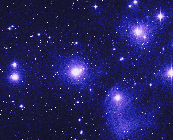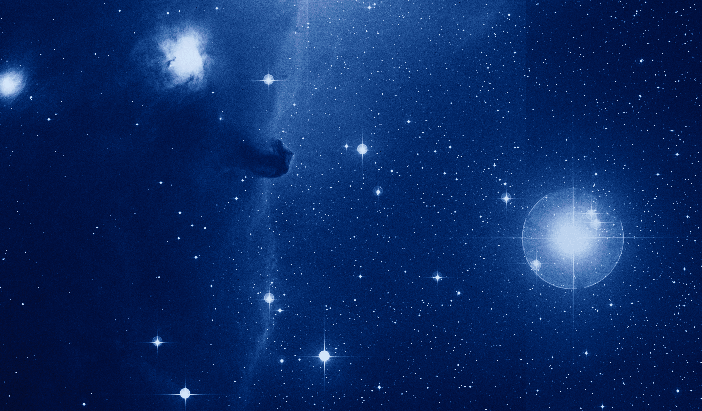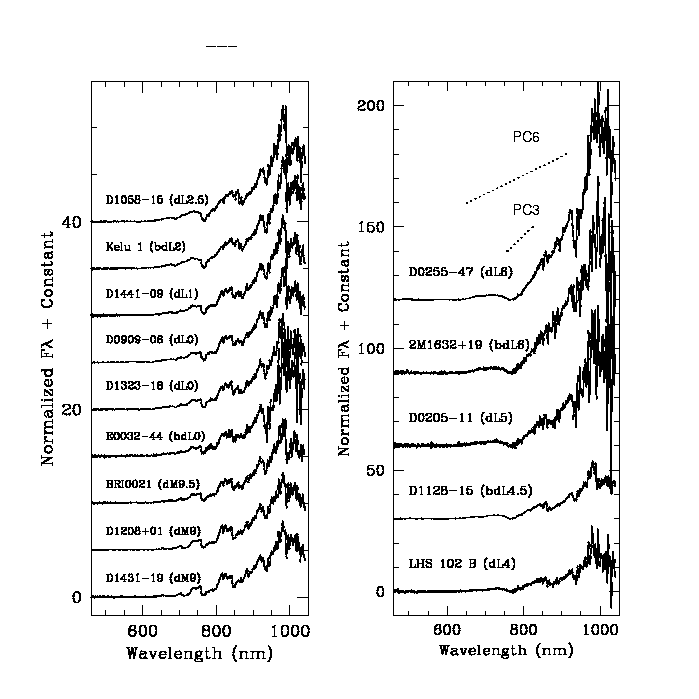 |
Discovery of a population of young, free-floating planetary mass objects (5-15 Jupiter mass) in the sigma Orionis star cluster.
Resulting from our combined optical (IZ) and near-IR (JK) exploration of an area of 847 sq. arcmin around the multiple O9.5 star sigma Orionis, we have found a young (5 million years) population of 18 isolated, cluster candidate members with masses below the deuterium burning threshold (13-15 Jupiter mass). These planetary mass objects will never show fusion nuclear reactions in their interiors, like the planets of our solar system. However, they are drifting alone across the cluster and are not associated to any star. Our findings suggest that old (with ages similar to the Sun) free-floating planetary mass bodies should be populating the galactic disk and the solar neighborhood. Their discovery (due to their extreme low luminosity and cool surface temperature) is a challenge for today's astronomers (Zapatero Osorio et al. 2000, Science, 290, 103 - abstract and toll free full text available here). |
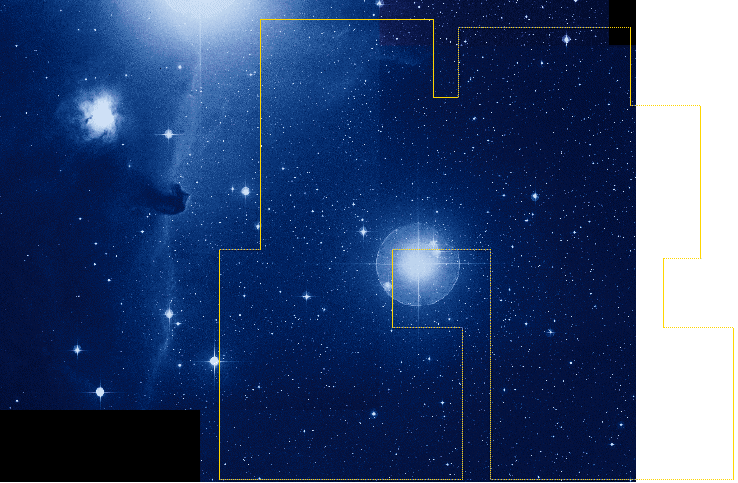 |
Total area of 1.15 sq. degree surveyed in the sigma Orionis cluster using the IZ bands.
In 1998 our group performed a deep CCD-based IZ search for the substellar population (brown dwarfs and giant planets) around the sigma Orionis star using the Wide Field Camera at the 2.5m Isaac Newton Telescope (ORM). The survey reaches limiting I-band magnitude = 24. This figure (North is up, East is left) presents the total area covered (yellow line) projected onto digitized Palomar Sky images. The central bright star is sigma Orionis, with the Horsehead Nebula lying to the East. More than 150 stellar and substellar candidates have been identified (Zapatero Osorio et al., 1999, in "11th Cool Stars, Stellar Systems and the Sun", Tenerife, Oct 4-8; Rebolo et al., 2000, in "Disk, Planetesimals and Planets", Tenerife, Jan 24-28). |
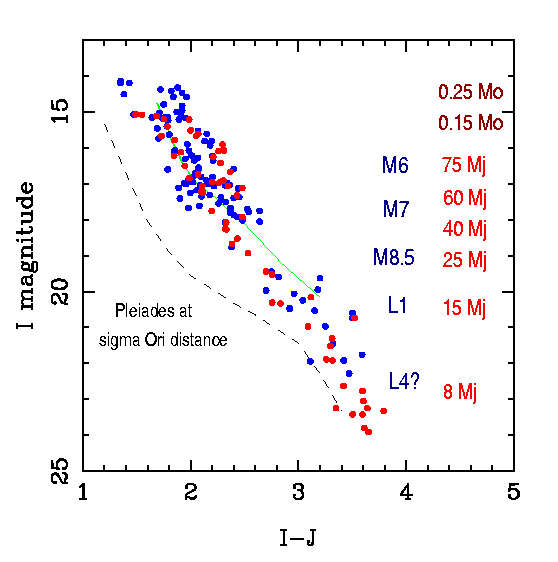 |
Color-magnitude IJ diagram for stellar and substellar candidate members of the sigma Orionis cluster.
Red symbols were selected from a combined I and J photometric survey covering 750 sq. arcmin around the multiple star sigma Orionis. Blue symbols correspond to point J observations of candidates identified in the 1.15 sq. degree survey originally performed in the I and Z bands. The green line denotes the NextGen model by the Lyon group for an age of 5 Myr. Spectral types (according to our spectroscopic data) and estimated masses for an age of 5 Myr (solar units for stars, and jovian units for brown dwarf and planet candidates) are indicated in the right-most columns. (Rebolo et al., 2000, figure presented at the Euroconference on "Disk, Planetesimals and Planets", Tenerife, Jan 24-28). |
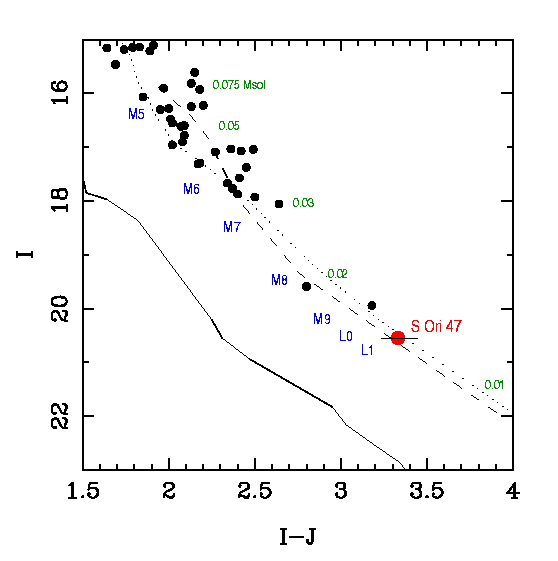 |
Location of SOri47 (red circle) in the optical-to-IR color-magnitude diagram.
Some other sigma Orionis cluster members (samll circles) are also plotted. The solid line corresponds to the average sequence of very low mass dwarfs shifted to the cluster distance. The theoretical isochrones of Burrows et al. (3 Myr, dashed line) and the Lyon group (5 Myr, dotted line) are overplotted to the data. Masses are given in solar units, and spectral types are labeled as a function of the I-J color. SOri47 is a substellar object with only 0.015 Msun (~15 Mjup) which is defining the deuterium burning mass frontier in the sigma Orionis cluster. (Zapatero Osorio et al., 1999, ApJ, 524, L115). |
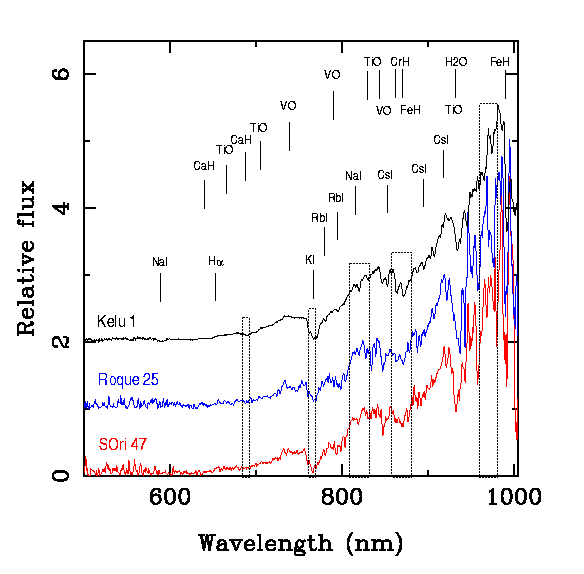 |
Keck low-resolution spectrum of the 0.015 Msun sigma Orionis member SOri47.
A boxcar smoothing of 3 pixels has been applied. This young substellar object has been classified as L1.5 type, showing an effective temperature around 1800-2000 K. The identification of some atomic and molecular features is given at the top. Telluric bands are marked with dashed lines. SOri47 is presented in comparison with other brown dwarfs of similar type, Kelu1 in the field and Roque25 in the Pleiades (Zapatero Osorio et al., 1999, ApJ, 524, L115). |
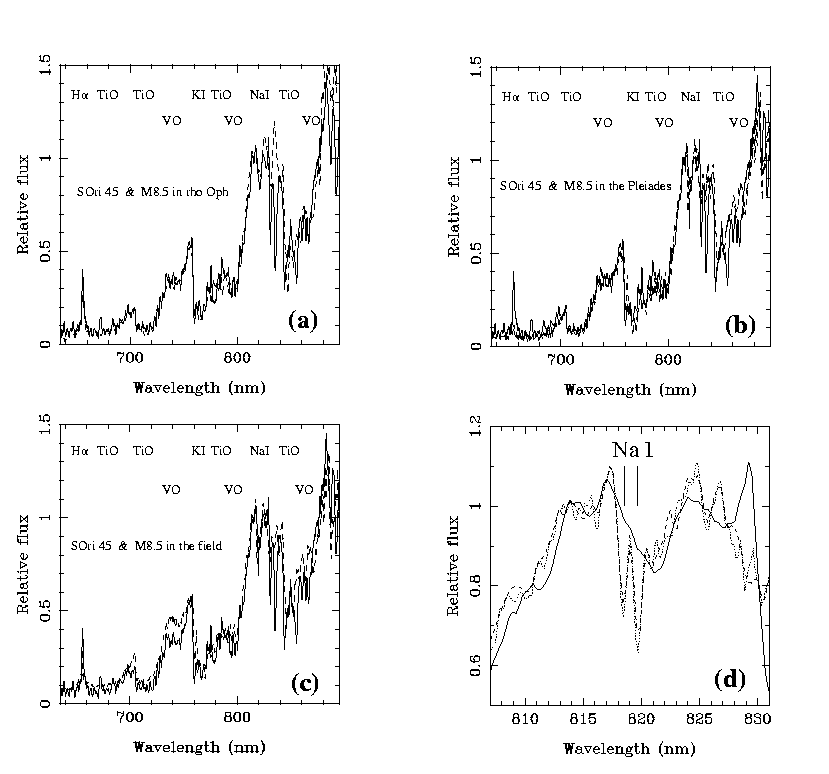 |
WHT low-resolution spectrum of the 0.025 Msun sigma Orionis member SOri45 (M8.5 spectral class, solid line).
Our spectrum is compared to spectral type counterparts (dashed line) in (a) Ophiuchus (Luhman et al.), (b) the Pleiades (Zapatero Osorio et al.) and (c) the field. In (d), an enlargement of the NaI doublet is presented, in which SOri45 is denoted by a solid line, and the Pleiades and field M8.5-type spectra are plotted with dashed and dotted lines, respectively. This figure shows the dependence of the optical spectra of very late-M classes with gravity: stronger TiO and VO molecular bands and weaker atomic features of the alkali (KI and NaI) in objects with low gravity (Béjar et al., 1999, ApJ, 521, 671). |
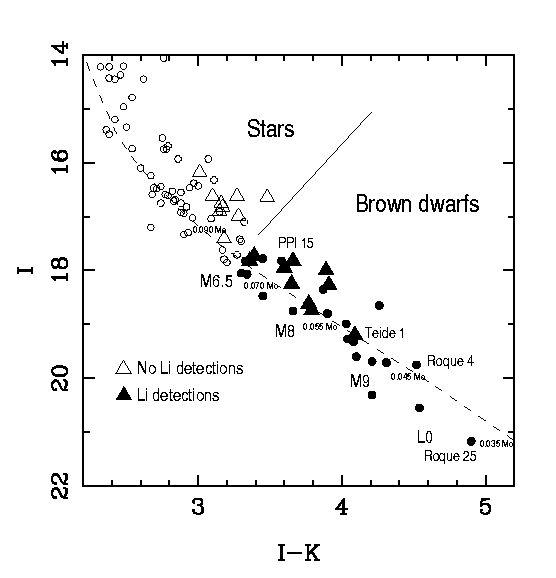 |
The substellar mass limit and the least massive members in the Pleiades.
Color-magnitude diagram in the IK bands for Pleiades low mass stars (open symbols) and brown dwarfs (filled symbols). The substellar limit (0.075 Msun) at the age of the cluster is given by the reappearance of the lithium feature in the spectra of Pleiads (denoted with triangle-shaped symbols in this figure). Spectral types are provided on the left side of the cluster sequence. Overplotted to the data is the theoretical dust-free, NextGen 120 Myr-isochrone (dashed line) from the Lyon group shifted to the distance and reddening of the Pleiades. Masses in solar units are indicated. Roque25, with a mass of 35 Jupiter masses and an L1 spectral type, is the least massive and coolest Pleiades brown dwarf so far identified. Other relevant brown dwarfs in the cluster are also labeled (Zapatero Osorio, 2000, in "Very Low Mass Stars and Brown Dwarfs", La Palma, May 5-11, in press). |
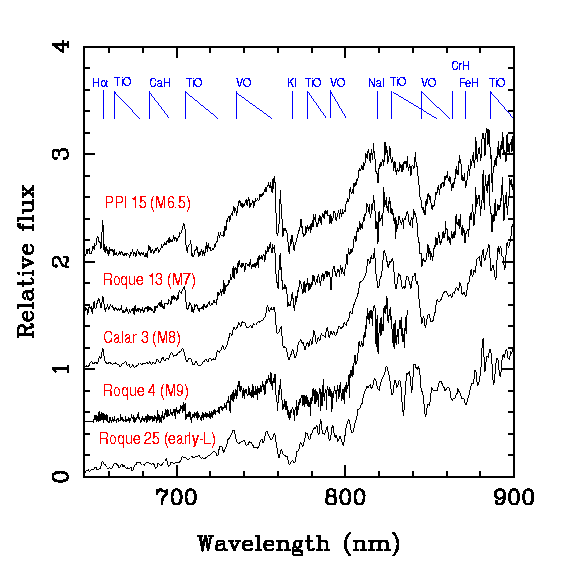 |
The spectroscopic sequence of brown dwarfs in the Pleiades.
Optical spectra collected with the WHT (PPl15, Roque13 and Calar8) and Keck (Roque4 and Roque25) telescopes for brown dwarfs in the Pleiades spanning a spectral class and mass ranges of M6.5-L1 and 0.075-0.035 Msun, respectively. For the first time it is possible to study the spectral classification for very cool temperatures using data of the same age, gravity and metallicity. The transition from the M-type to the L-type in the Pleiades takes place at about 2200 K (Zapatero Osorio, 2000, in "Very Low Mass Stars and Brown Dwarfs", La Palma, May 5-11, in press; Martín et al., 1998, ApJ, 507, L41). |
 |
Lithium in Pleiades stars and brown dwarfs.
Very low mass convective stars efficiently destroy their initial lithium content as it is indicated by the shallow decay in the abundance of this element (blue dots) and by the non-detections given by the upper limits at around 3000 K. On the contrary, brown dwarfs do preserve it (red dots), and the reappearance of lithium in the atmosphere of these fully convective substellar objects at around 2800 K denote the frontier between stars and brown dwarfs at the age of the Pleiades (120 Myr). So far there are some lithium positive detections for cluster brown dwarfs and this is indicated with as many symbols as detections in the way between PPl15 and Teide 1. Masses in solar units are given at the top of the plot (figure updated from Rebolo et al., 1995, Nature, 377, 129). |
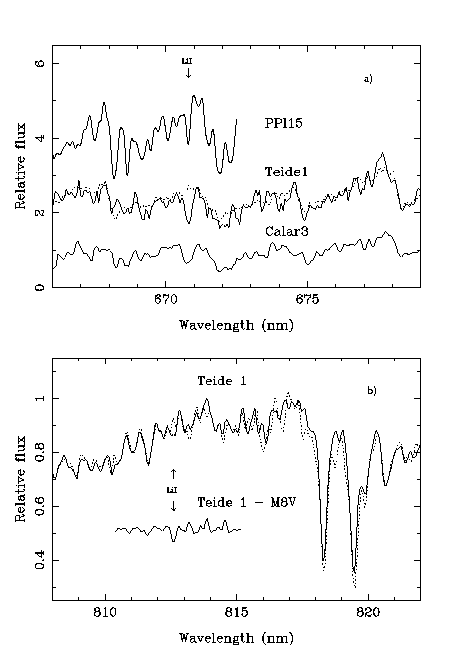 |
Lithium in Teide1 and Calar3.
The spectral region around the LiI 670.8 nm line in Teide1 and Calar3 (two Pleiades brown dwarfs of 55 Jupiter masses) is displayed in the upper panel. Overplotted to Teide1 is the spectrum of a field M8-type standard star (dotted line) with no lithium. This provides a clear contrast between the presence (Teide1 and Calar3) and the non-presence of this atomic feature in the data. Also plotted for comparison is the spectrum of PPl15 degraded to the same resolution than the previous ones. The lower panel shows the spectral region around LiI 812.6 nm in Teide1. The substraction of Teide1's spectrum with that of the M8 field standard stars provides an evidence for this little atomic line, which confirms total preservation of lithium in the atmosphere of the Pleiades brown dwarf Teide1 (Rebolo et al., 1996, ApJ, 469, L53). |
